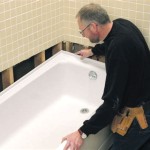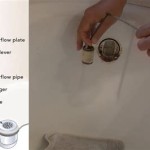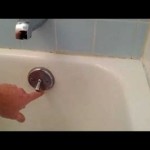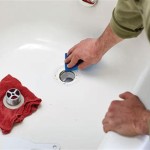Replace Bathtub Faucets: A Step-by-Step Guide
Replacing a bathtub faucet is a relatively simple plumbing task that most homeowners can tackle themselves with a few basic tools and materials. By following these steps, you can save the cost of hiring a plumber and enjoy the satisfaction of a job well done.
Tools and Materials You'll Need:
- Adjustable wrench
- Faucet wrench
- Channellock pliers
- Plumber's putty
- Teflon tape
- New bathtub faucet
- Bucket
- Old towels
Step 1: Turn Off the Water Supply
Before starting any plumbing work, it's crucial to turn off the water supply to the bathtub. Locate the shut-off valves under the sink or behind the access panel and turn them clockwise until the water is completely off.
Step 2: Remove the Old Faucet
Place a bucket under the faucet to catch any water that may drain out. Using a faucet wrench, loosen the locknut connecting the faucet to the water supply lines. Remove the old faucet by gently pulling it straight up.
Step 3: Clean the Faucet Base and Apply Plumber's Putty
Remove any remaining old plumber's putty or debris from the faucet base where the new faucet will be installed. Apply a rope of plumber's putty around the base of the new faucet and press it into place to create a watertight seal.
Step 4: Install the New Faucet
Align the new faucet with the water supply lines and gently insert it into the base. Tighten the locknut by hand and then use the faucet wrench to fully secure it. Be careful not to overtighten, as this could damage the faucet or the water supply lines.
Step 5: Connect the Water Supply Lines
Wrap the threads of the water supply lines with Teflon tape to prevent leaks. Connect the hot and cold water lines to the corresponding valves on the faucet. Use an adjustable wrench to tighten the connections, but again, avoid overtightening.
Step 6: Install the Handle and Spout
Depending on the type of faucet you have, you may need to install the handle or spout. Follow the manufacturer's instructions to properly align and secure these components.
Step 7: Turn on the Water Supply and Check for Leaks
Slowly turn on the water supply valves and check for any leaks around the base of the faucet or the connections to the water supply lines. If you notice any leaks, tighten the connections or apply additional plumber's putty as needed.
Congratulations, you have successfully replaced your bathtub faucet!

How To Replace A Mobile Home Bathtub Faucet Parts Latest News

How To Replace A Bathtub Spout Diy Family Handyman

How To Replace A Bathtub Faucet In 4 Easy Steps

Learn How To Remove And Install Various Tub Spouts

How To Install A Tub Spout The Home Depot With Thisoldhouse

Replacing Shower Tub Faucet How To Install A New

How To Replace A Bathtub Faucet

How To Replace A Tub Spout Project Tutorial Bob Vila

Installing A Tub Faucet Fine Homebuilding

How To Fix A Leaking Bathtub Faucet The Home Depot
Related Posts








